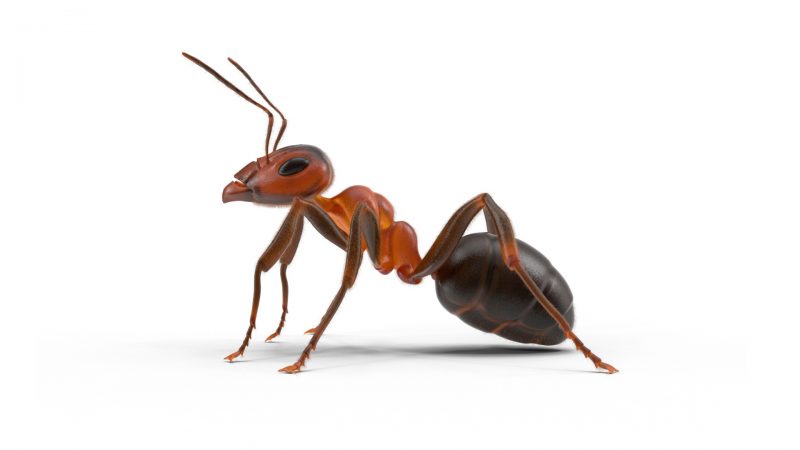Allegheny mound ant infestations can greatly threaten your lawns, farmlands, and households. These tiny insects have the potential to kill small trees, shrubs, and vegetables. These ants live in mounds, and they inject formic acid into the surrounding vegetation to clear the area within 40 to 50 feet of them.
How to get rid of Allegheny mound ants? There are two effective methods that can be used to get rid of the Allegheny mound ants. First, you need to locate their mounds (colonies), and then you can choose what type of method or insecticide to use (ant baits, liquid, or granular ant killers).
This article will provide a complete guide about the Allegheny mound ants, how to identify them, their life cycle, prevention techniques, management, and control methods.
Allegheny Mound Ant: Information and Facts
What is an Allegheny mound ant? Allegheny mound ant (Formica exsectoides) also referred to as ‘field ant.’ These species of ants are native to North America. They are also found on Atlantic Coast from the land of Nova Scotia (Canada) to some areas of Georgia.
The word Formica exsectoides originates from the Latin word Formica which means ‘ant’, and expects ‘to cut out’. This name is given to this species of ants because of their method of infestation (by clearing vegetation) in the fields.
How Does the Allegheny Mound Ant Look Like?

They are 1/4 to 1/8 inch long, their head and thorax are red whereas the legs and abdomen are dark brown to black. The abdomen tip is covered with hairs, and the workers of this ant species have different sizes. They can be mistaken for fire ants due to their similar appearance. The antennae of the Allegheny mound ants are segmented (12 segments).
Allegheny mound ants create formic acid and inject it into the plants or vegetation to clear the site for mounds. The use of acid results in the death of the young plant (vegetation).
Allegheny Mound Builder Ants: How and Where Do They Live?
Allegheny mound ants can establish their colonies in a wide range of habitats from marine wild fields to open forested areas, in the backyard, residential areas, gardens, farmlands, pasture areas, or in open fields, etc.
These ants dig large mounds and tunnels or make anthills in the open fields to establish colonies. Workers select the site of the mound and defend the colony. Their mounds can be tall, up to 3.3 feet, and wide, about 6.6 feet. During the first 2 weeks, they can build a canonical mound about 8 -13 inches wide. After 5 months of building, the mound can get up to 2 feet wide and 8 inches tall. After 2 years, the mound can be up to 3 feet deep and 4 feet tall.
The trees 2-5 years old and up to 8 inches tall are more susceptible to the Allegheny mound ants attack. These ants extend their mounds by mound budding and form multiple colonies from a single colony.
The single established colony has many workers, drones, and multiple queens, which may also be linked to other Allegheny mounds’ colonies. This can often result in super-colonies. These ants prefer areas under sunlight to keep their mounds warm for the incubation of a new colony.
Allegheny Mound Ants Life Cycle
Allegheny mound ants develop their colonies rapidly. The single generation completes its life cycle from egg to adult in about 2 to 3 months and can be varied according to temperature. The workers help incubate eggs and pupae to establish a colony. The ants dig the mound in spring and early summer and escort the mated queen, which lays eggs.
The eggs develop into larvae in 2-4 weeks. The workers take care of legless white larvae and protect them from harsh conditions. They collect food for the larvae and nourish them. In about 3 to 7 weeks, the larvae develop into pupae. After 2 weeks, the pupae grow into an adult (light in color). A mound can remain active for an extended period of up to 30 years.
What Does the Allegheny Mound Ant Eat?
The Allegheny mound ants’ survival depends on both living and dead matter. They prey upon carbohydrate secretion or the honeydew secreted by different pests or aphids. The Allegheny mound ants are scavengers that feed on dead matter, leaves, twigs, arthropods, and more. They prey upon beetles, small bugs, caterpillar larvae, grasshoppers, flies, treehoppers, wasps, gypsy moths, crickets, white pin weevils, and so on.
Can Allegheny Mound Ants Damage My Garden or House?
If the Allegheny mound ants establish their colonies in your lawn. They can cause serious damage to your vegetation, and they can destroy farmlands in months. These pests have the potential to kill plants within the range of 40 to 50 feet from their mounds.
They prefer to live in open field areas. However, if you form a nest in your house, it can spoil your food and carry diseases from dead or contaminated matter. The Allegheny mound ant infestation can be helpful at the beginning because they kill garden pests and increase soil fertility. Still, in larger numbers, they can be destructive for your field.
Are Allegheny Mound Ant Bites Dangerous?
Allegheny mound ants will not bite until you approach their mounds or if they feel threatened. They do not sting, but their bite is painful. These ants inject formic acid into your skin during the bite, which causes irritation and swelling of the area.
Allegheny Mound Ant Bites Treatment
Here are the simple home remedies to cure ant bites:
- Apply diluted apple cider vinegar on the infected skin area. It will take away the burning sensation.
- You can also apply honey or toothpaste on the skin for quick relief from an ant bite.
Allegheny Mound Ant Control | Pest Control Methods

The first step of the pest control method is the detection of mound ant infestation. These ants start their colonies by forming mounds. You should be prepared to take strict measures if you see ant mounds on your land. After establishing a single colony, the queen moves to another mound and starts establishing another colony.
Their rapid growth and the presence of multiple queens can make it hard for you to eliminate them. For these reasons, we have devised a strategy combining different control methods to eradicate their infestations.
Related: Are Ants the Smartest Insect? | It depends!
How to Get Rid of Allegheny Mound Ants: Basic Instructions
Several control methods are used to get rid of Allegheny mound ants. The most commonly known method to control these pest infestations is the application of insecticides.
- The liquid or granular insecticides are poured directly into the mound of Allegheny mound ants to destroy their establishment on your land. Then remove the mounds, level the ground in the field, and keep an eye on it after insecticide application to stop their re-establishment.
- Slow-acting ant baits are also used to lure these ants and to get rid of their entire colonies. If the workers get attracted to the bait and feed on it, including the queen. The bait will cause the death of the entire colony. However, if the infestation is more extensive, integrated pest management techniques should be employed.
- To prevent their attack inside your house, seal all the cracks, crevices, holes, tunnels, or sideways and take extra care of cleanliness and sanitation. The Allegheny mound ants depend on honeydew-producing insects, dead matter (scavengers), or meat, which is why it is crucial to keep your house clean.
Allegheny Mound Ants Elimination | Chemical Method
Slow-acting ant baits can help to lure and kill the Allegheny mound ants. The worker ant will take the bait to their nests, and if all queens ingest this bait. It will cause the death of the colony. However, a single queen’s survival means that colony’s survival.
Therefore, to completely get rid of their colony and on time, use liquid or granular insecticide along with ant baits. If you want to stay environmentally friendly, use just ant baits to eliminate the Allegheny mound ants. We recommend the following products:
TERRO Ant Bait Killer
- Attracts & Kills – Kills common household ants including...
- Kills the Ants You See & the Ones You Don't – As worker ants...
- Works Fast – You should see a significant decrease in the...
- Ready to Use – Place the bait stations, watch it attract ants,...
- Use Throughout Your Home – Place stations near areas where...
Syngenta – TRTD11568 – Optigard Ant Bait Gel Box
- Target pests: For indoor and outdoor control of...
- Highly attractive formula promotes ready transfer of the active...
- Powerful, active ingredient knocks out workers, brood and queens
- Approved for use indoors and outdoors, applied in cracks and...
- How does Optigard Ant Bait Gel work? Ants that feed on the gel...
Ortho Orthene Fire Ant Killer
- Ortho Orthene Fire Ant Killer1 kills the queen and destroys the...
- KILLS IN MINUTES: This treatment takes only minutes to apply, and...
- KILLS THE QUEEN & DESTROYS THE MOUND: Killing the queen of a fire...
- EASY APPLICATION: Simply sprinkle the product over each mound...
- USE AS PART OF ORTHO 2-STEP SYSTEM: First, destroy existing...
Application of Insecticides
Applying insecticide is an effective solution to get rid of Allegheny mound ants. Follow these steps to have better results:
- Search and inspect the mounds in the infested area and mark them. Measure the diameter of mounds to understand better what you are dealing with (some products have exact dosing based on the diameter of the mounds).
- Before the application of an insecticide, remove the mounds from the top. Use the shovel to scrape the top of the mounds to completely expose it.
- After exposing the mound, pour about 1 gallon of insecticide into the mound (liquid or granular) to level it completely. Increase the quantity of insecticide if necessary. Repeat the process for every mound.
- The smaller anthills can be eradicated by scraping and by applying lower amounts of insecticide, whereas larger mounds, in some cases, would require about 5 gallons of insecticide.
- It is important to note that different products have different application methods, so it is important to read instructions on each one.
Note: Wear gloves and long pants to protect yourself from ant bite. Use a brush to remove ants on the body.
Some insecticides that can be used are spinosad, phosmet, and cypermethrin containing Demon WP, Demon EC, Cynoff WP, and Cynoff EC. The liquid insecticides containing deltamethrin, carbaryl, permethrin, or cyfluthrin are also effective against Allegheny mound ants
Follow the manufacturer’s labels and instructions for the application of insecticides. After employing the pest control methods, keep an eye on the infested area for a few weeks to make sure that you have entirely gotten rid of these ants.
Allegheny Mound Ants Elimination | Biological Control
The fungus named Beauveria bassiana can control the Allegheny mound ants to a limited extent. This method will not eliminate the infestation of ants. This fungus can be introduced in the land if you want to control the population of Allegheny mound ants. As we have said, these ants are suitable for controlling other pests, such as aphids or other garden pests.
Home Remedies for Getting Rid of Allegheny Mound Ants | Natural Methods

Boric Acid Solution
To make the boric acid bait at home, mix 1.5 tablespoons of boric acid, and 1/2 cup of sugar in 1.5 cups of warm water. Soak a cotton ball in the solution to saturate it. Place it near the infested area to lure them.
Vinegar and Lemon Solution
Mix vinegar and water in equal amounts to prepare the vinegar insecticide spray. Pour it directly on the ants to control their infestation. Mix ¼ cup of lemon juice in ¾ cup of water to make the lemon juice solution. You can apply the solution directly to kill the ants.
Soap Solution
Mix 2 teaspoons of liquid soap in a cup of warm water to make a soap solution. Spill it directly on the ants. The boiling soapy water can increase efficiency by up to 60 – 70%. Be careful when applying water, as soapy water can harm the surrounding vegetation.
Camphor Oil Solution
To prepare camphor oil solution, Take 1 cup of camphor oil and mix it in 9 cups of ethyl alcohol. For more solution, double the quantity of oil and ethyl alcohol (1:9). Scrape the top of the ant mound and pour the solution.
Note: The remedies may not kill all the colonies at first. Apply multiple treatments to eliminate Allegheny mound ants. You may prepare the correct quantity of solution by analyzing the area of infestation.
How to Prevent Allegheny Mound Ants From Invading Your House or Garden

The Allegheny mound ants mostly live in open lands and rarely come into the house in search of water or food. To prevent their entry into the house, seal all the gaps, crevices, holes, or cracks, including pipes and windows, and every possible entry point.
Keep your environment neat and clean, and do not leave leftovers or garbage in your house. Apply non-repellent insecticides around your house and in the foundation of walls to prevent their entry. The mound ants do not prefer dense vegetation or shady area where direct sunlight is disrupted.
List of Sources
Townsend L., Allegheny Mound Ants in Kentucky, University of Kentucky College of Agriculture
Allegheny Mound Ant, University of Maine Cooperative Extension
Mound ants, Michigan State University Extension
Bristow C. M., Cappaert D., Campbell N. J., Heise A., (1992), Nest structure and colony cycle of the Allegheny mound ant
Formica exsectoides, ITIS
Biology and control of the Allegheny mound ant, Journal of Economic Entomology
- How to Get Rid of Copperheads | Practical Guide - August 27, 2023
- How to Get Rid of Corn Snakes | What Makes Them Aggressive? - August 27, 2023
- How to Get Rid of Alligators | Safety Measures and Removal Methods - July 16, 2023



